If you do make it to the Bolavean Plateau, you’ll definitely be rewarded with a unique experience. I loved driving around the rural landscapes with the wind in my face and having the freedom to explore.
While you can see the Bolaven Plateau as part of a local tour, the best way is to drive it yourself by motorbike (scooter), which is what I opted to do.
The common route, called the “Bolaven Loop”, takes several days and conveniently starts and ends in the city of Pakse.
Driving the Bolaven Loop
- Minimum time: 2 days (small loop) or 3-4 days (big loop)
- Costs: approx. 120,000 kip ($6) per day for a scooter. Basic accommodation 300,000 kip to 600,000 kip per night (local basic hotel room or guesthouse)
- Distance: 320km (198 miles) for big loop, 199km small loop
- Difficulty: easy — mostly paved flat roads
Driving around the Bolaven Plateau was one of my favorite experiences in Laos. You’ll see some incredible waterfalls, including the awe-inspiring 120-meter-tall Tad Fane, and get a great taste of authentic rural Laos.
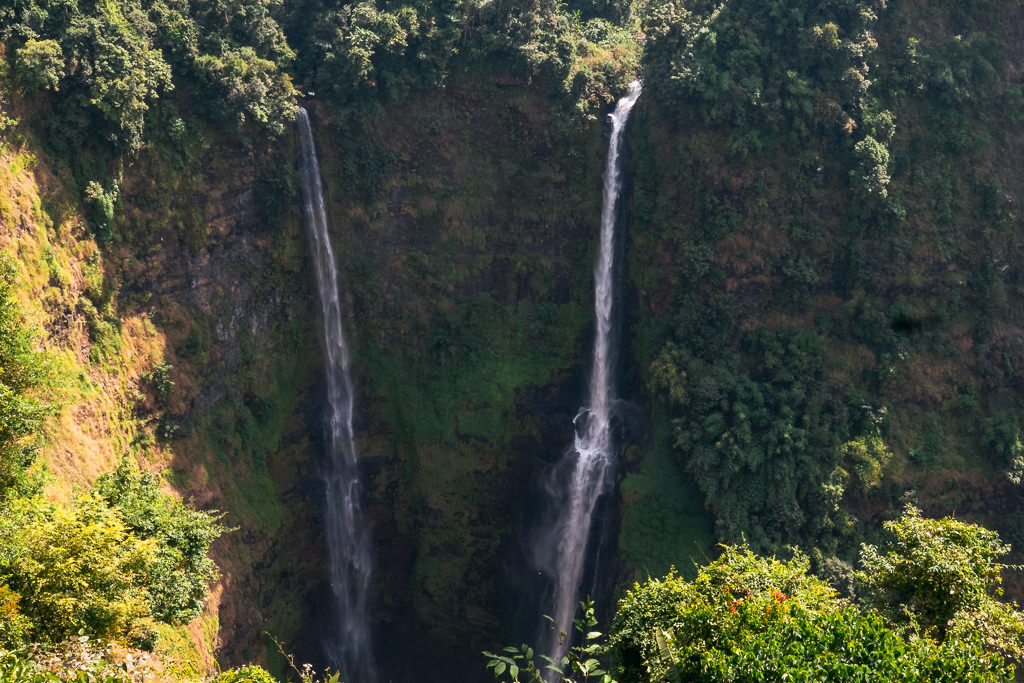
If you extend the route a bit, you can also visit a Khmer Hindu temple complex south of Pakse. There you can clamber around the ruins with hardly any tourists in sight in quite a contrast to the crowded archeological sites in Thailand or Cambodia.
I’ll recount my trip through the Bolaven Plateau, before offering some practical tips on how you can plan a trip of your own.
Day 1: Wat Phou & Mekong River
Okay, this is technically not part of the Bolaven motorbike loop.
But while you’re here anyway, you might as well add it to your itinerary, as it adds some very interesting sights to your trip.
(Note: You can also easily do this a day trip from Pakse.)
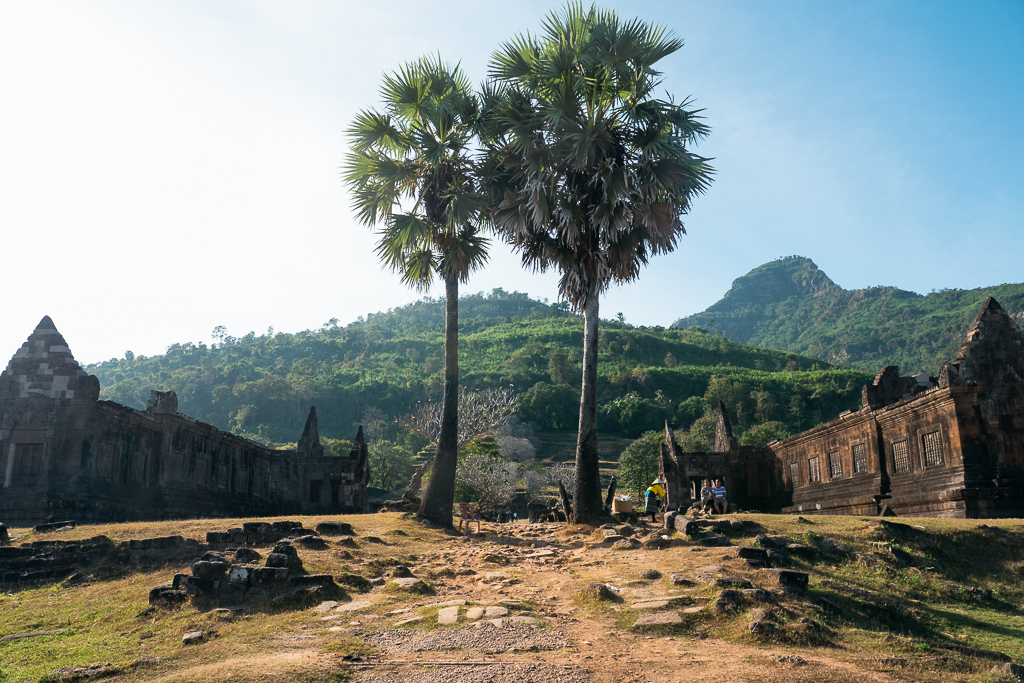
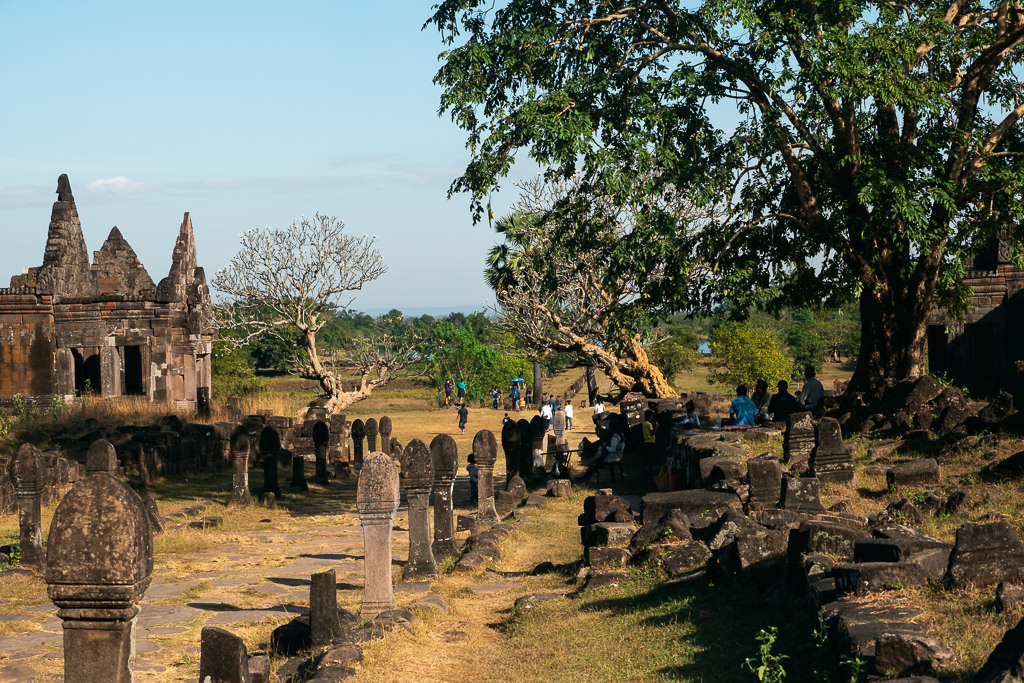
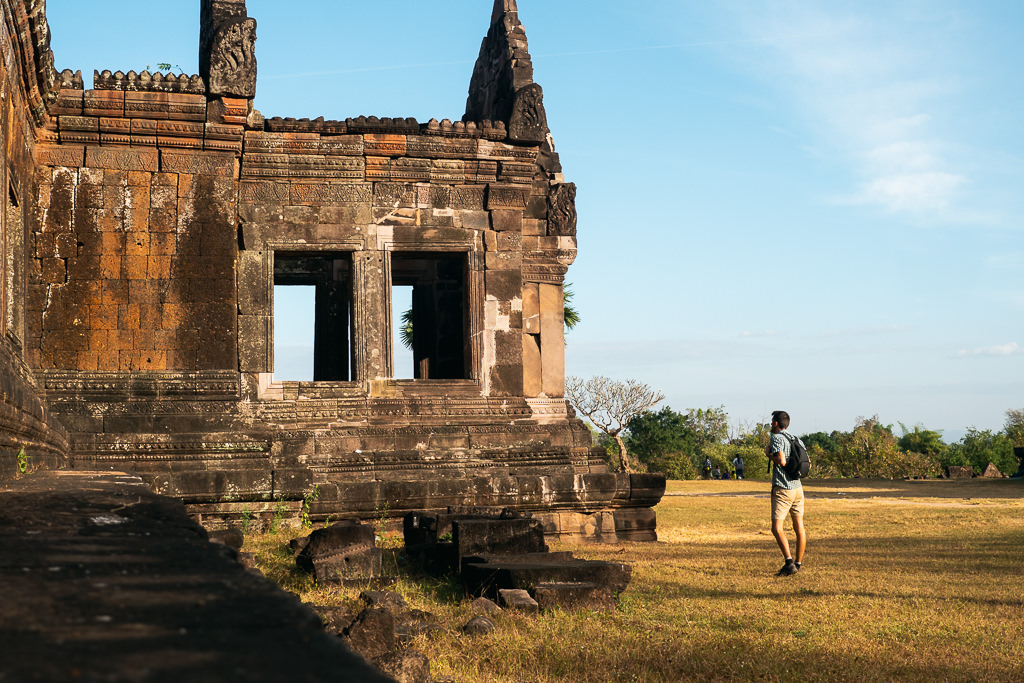
Drive about two hours south from Pakse — along the west bank of the mighty Mekong Driver — and you’ll get to Wat Phu (also spelled Vat Phou), a ruined Khmer Hindu temple complex on a hillside.
These ruins may lack the grandeur of the sprawling complexes found in Thailand or Cambodia, but I think it’s a highly worthwhile excursion. Even if you’ve already seen your share of temples in Asia, this one may feel a bit different. It’s just a wonderfully tranquil site with mostly a few locals coming here to pray or to picnic (plus maybe a few handfuls of foreign tourists).
I loved the quiet atmosphere at the site and climbing the hill for some fantastic views!
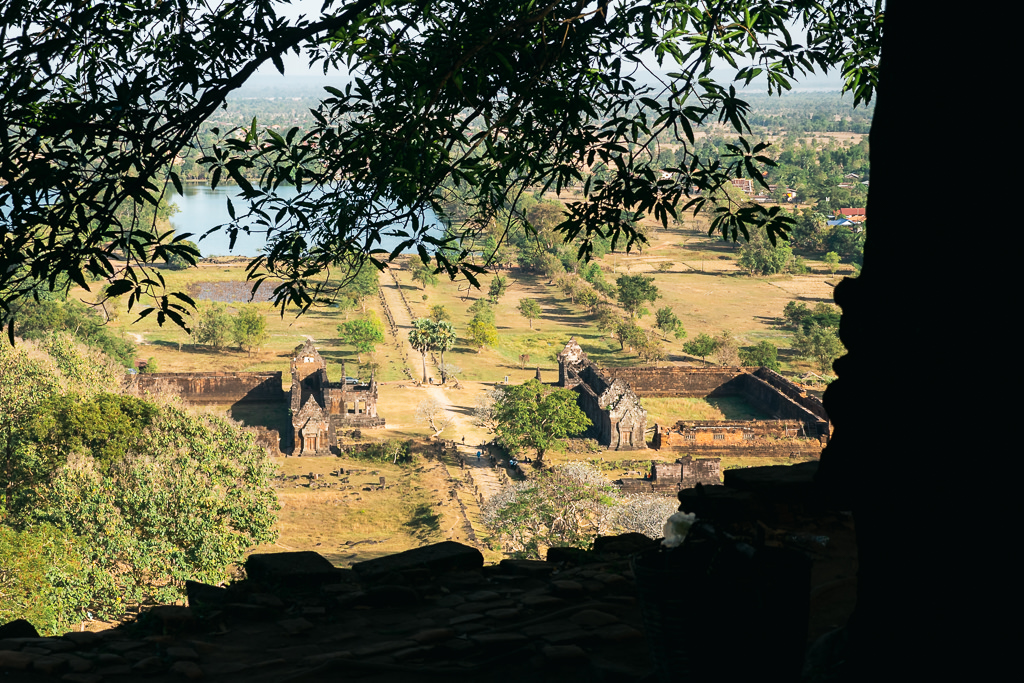
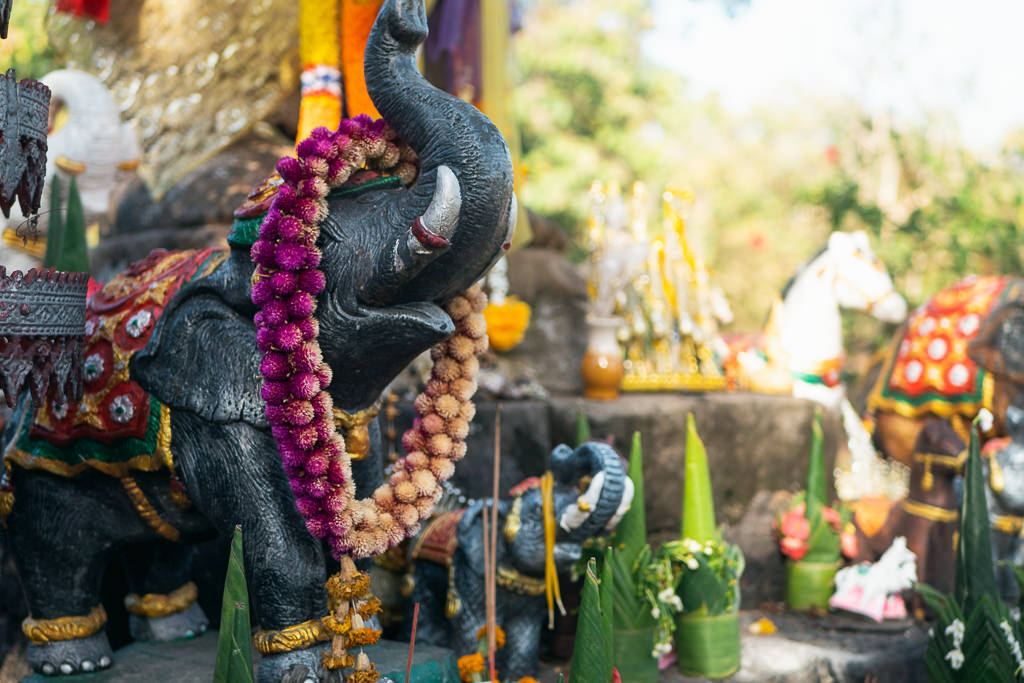
Tracing the Mekong River, you can slowly drive back north towards Pakse. It’s fun to cross the river to the other side on one of the rickety wooden ferries.
You can either stay the night in Pakse (as I did) or continue onwards to the start of the Bolaven Loop.
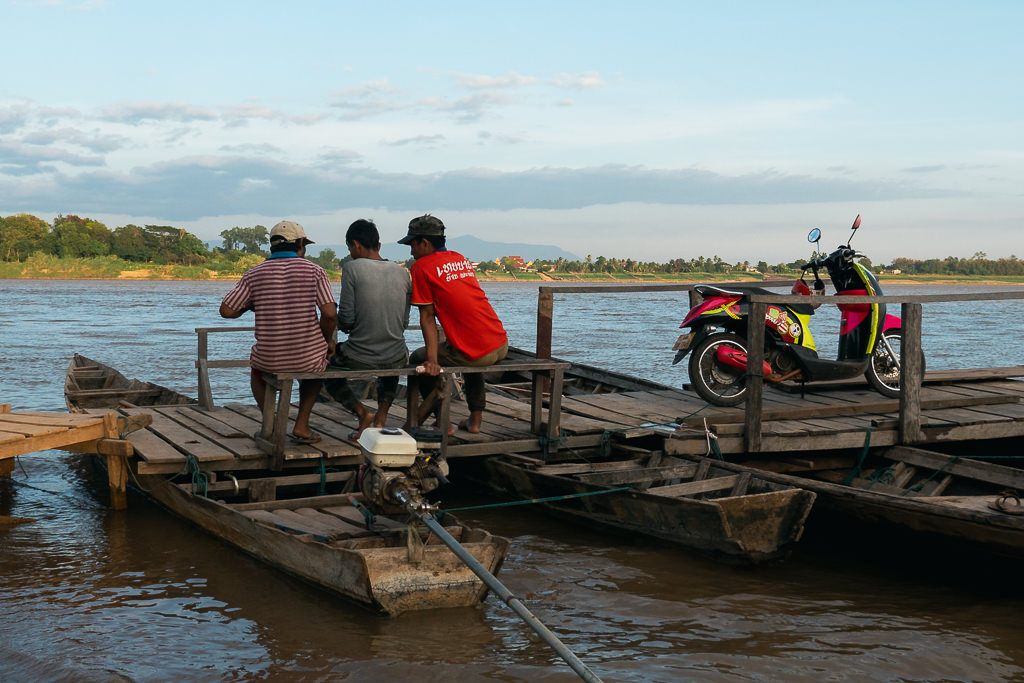
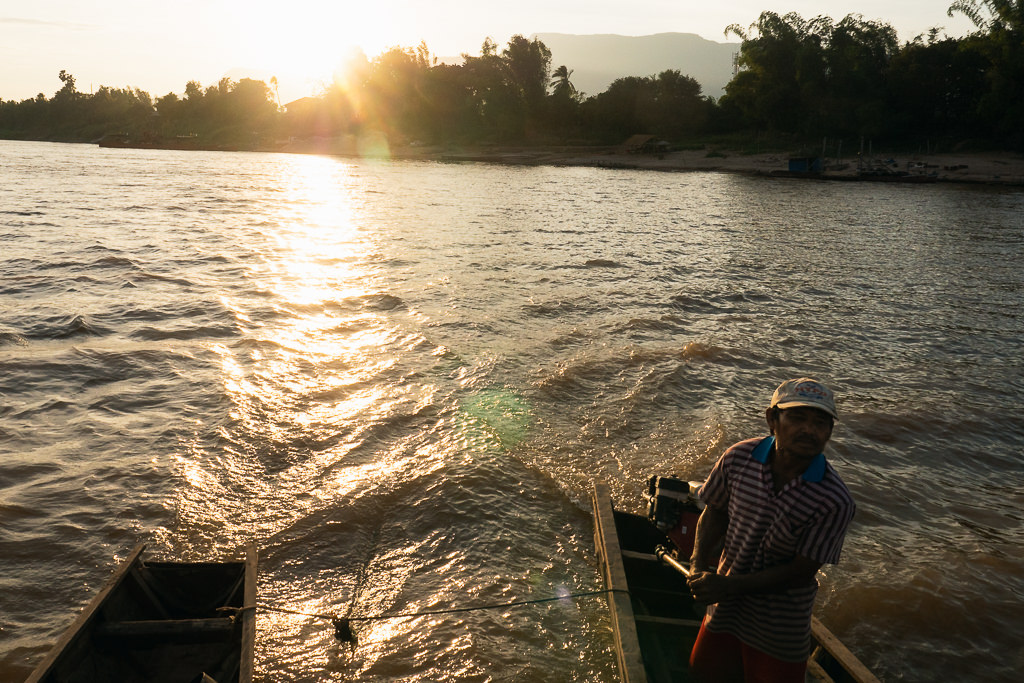
Day 2: Pakse to Tad Lo
Woohoo, day one of the Bolaven Plateau loop! Let’s dooo thiiiisss!
Okay, to be honest, after the first few hours of driving, my initial enthusiasm fizzled out a bit. The road heading east from Pakse is very busy, very straight, and rather dull. I was worried the rest of the drive would be similar, but luckily the road becomes more narrow and rural as you make your way to Tad Lo. Soon you will see plenty of farmers working in the fields and drivers waving as you pass them.
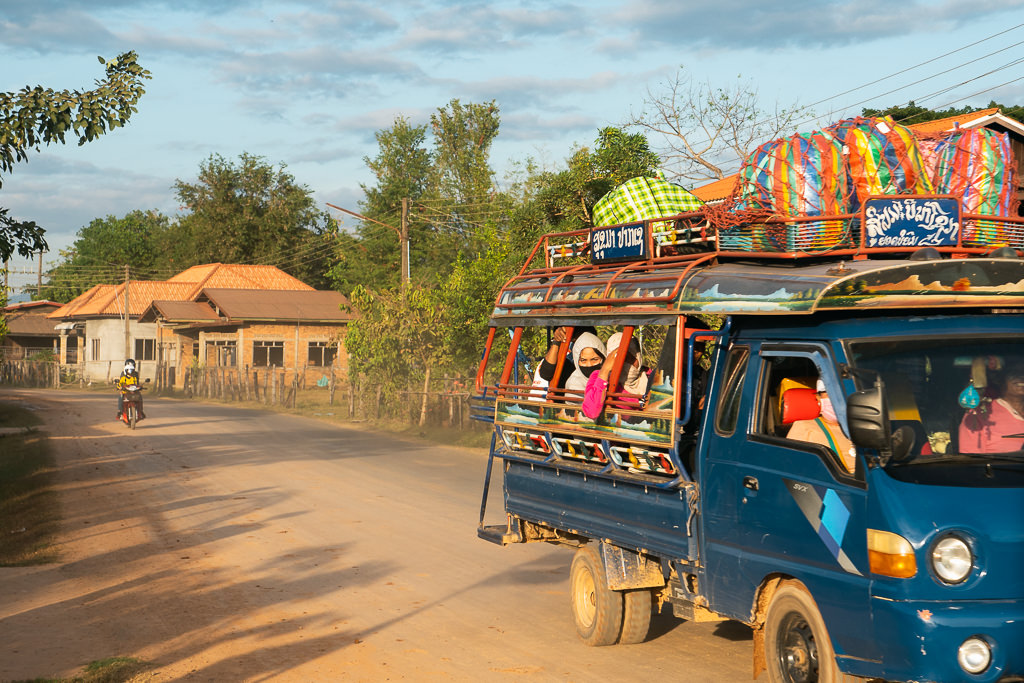
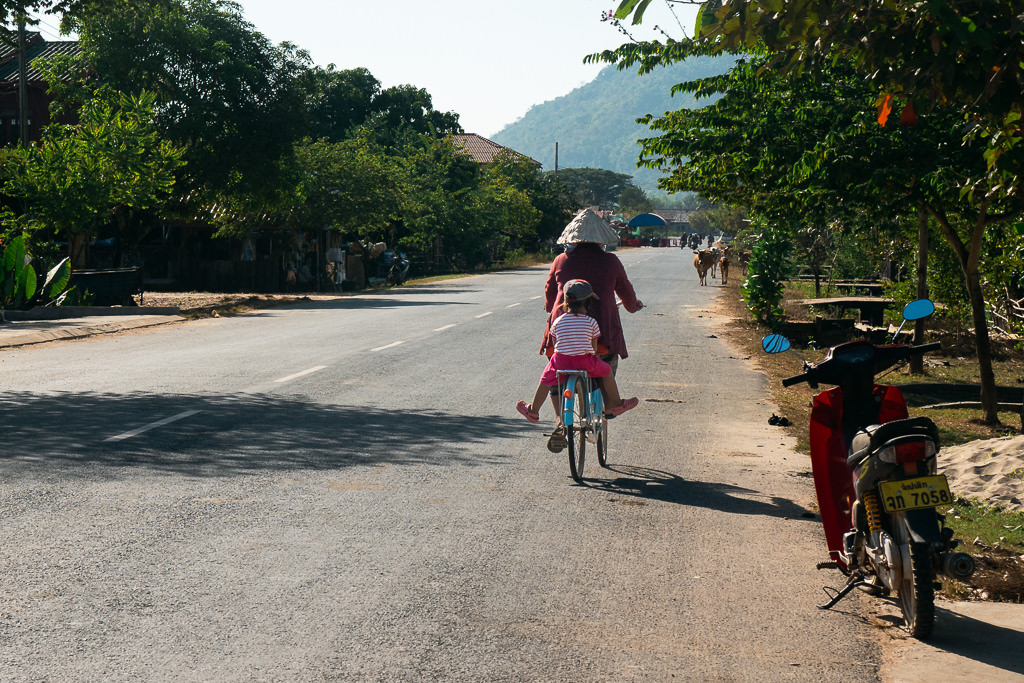
At the advice of my bike rental company I skipped the waterfall of Tad Champee and went straight to Tad Lo, a small set of waterfalls next to a peaceful village.
There are some homestays, backpacker-style guesthouses, and cozy Laos restaurants here, and it’s a lovely quiet place to stay.
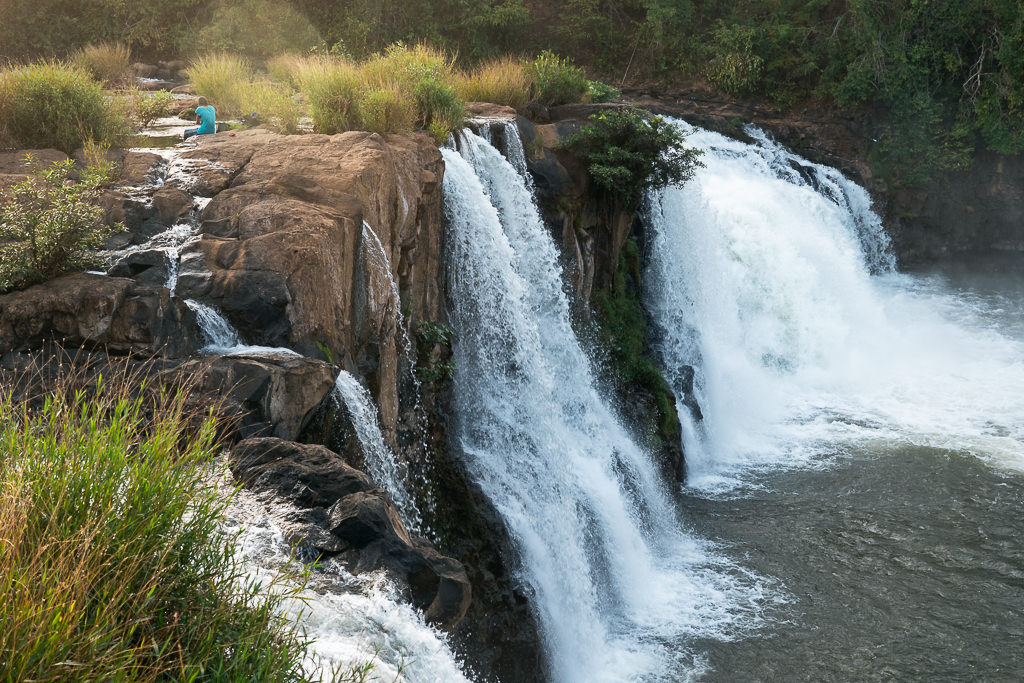
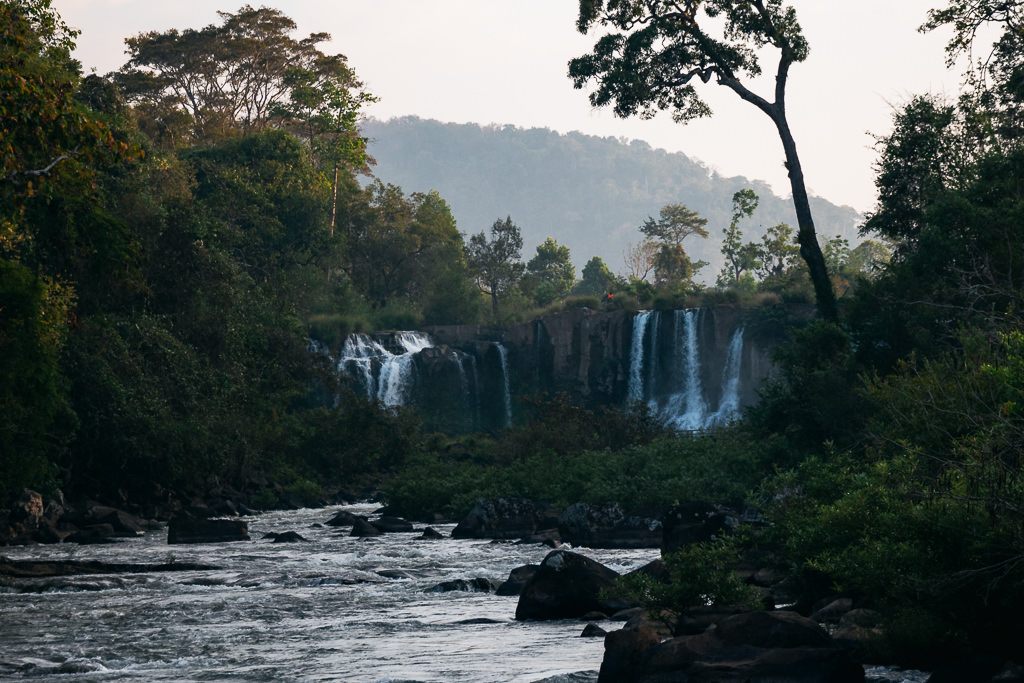
Before sunset, I caught the daily bath of an elephant that lives at one of the lodges.
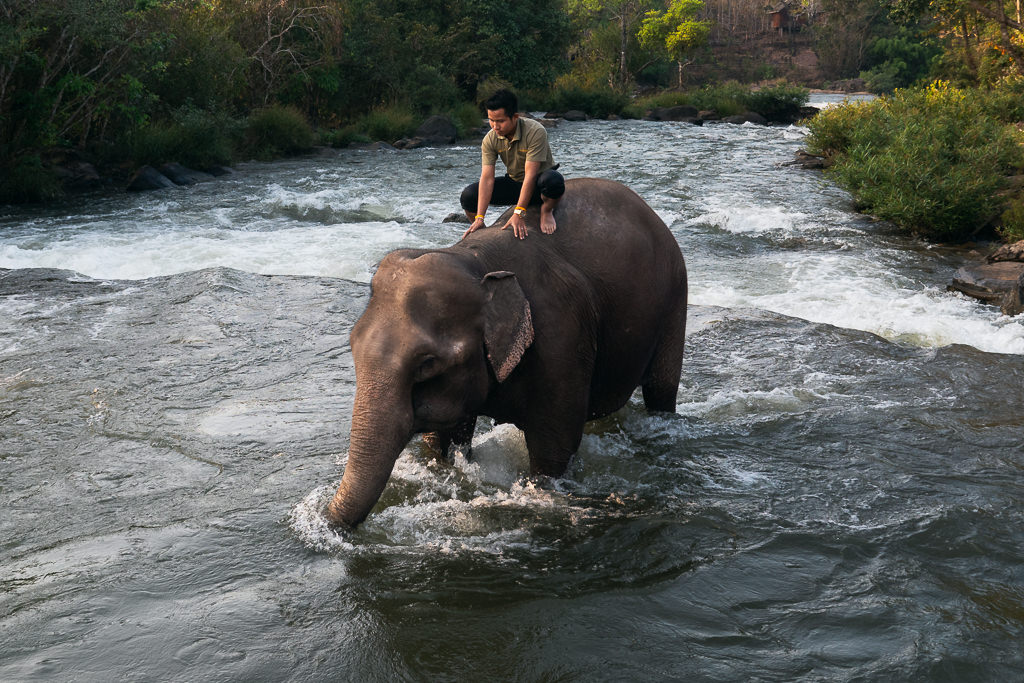
Near Tad Lo is also a traditional Katu village where you can meet Mr. Hook, a highly talkative local guide who takes small groups on impromptu tours.
It’s maybe strange to say this but meeting Mr. Hook is one of the highlights of this Bolaven trip. He’s quite the legend!
Every tour he does is different, and Mr. Hook is known to go on extended rambles about anything and everything. But mainly he talks about the coffee growing process, the beliefs and culture in the village, and interesting facts about the indigenous plants and trees. Some tours last 30 minutes, others apparently for hours (if you let him).
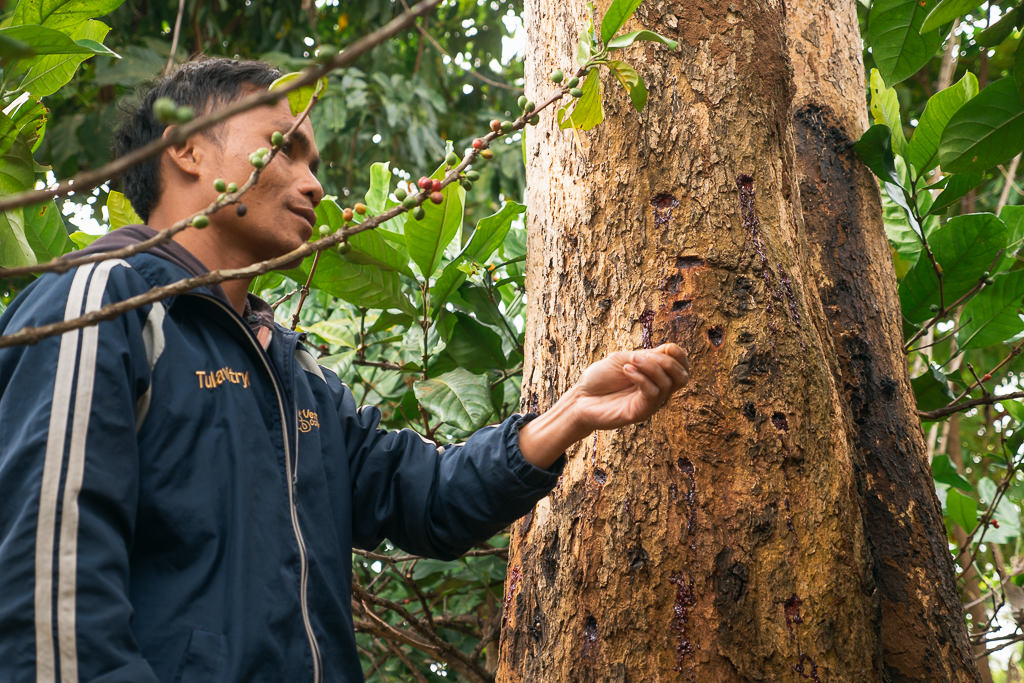
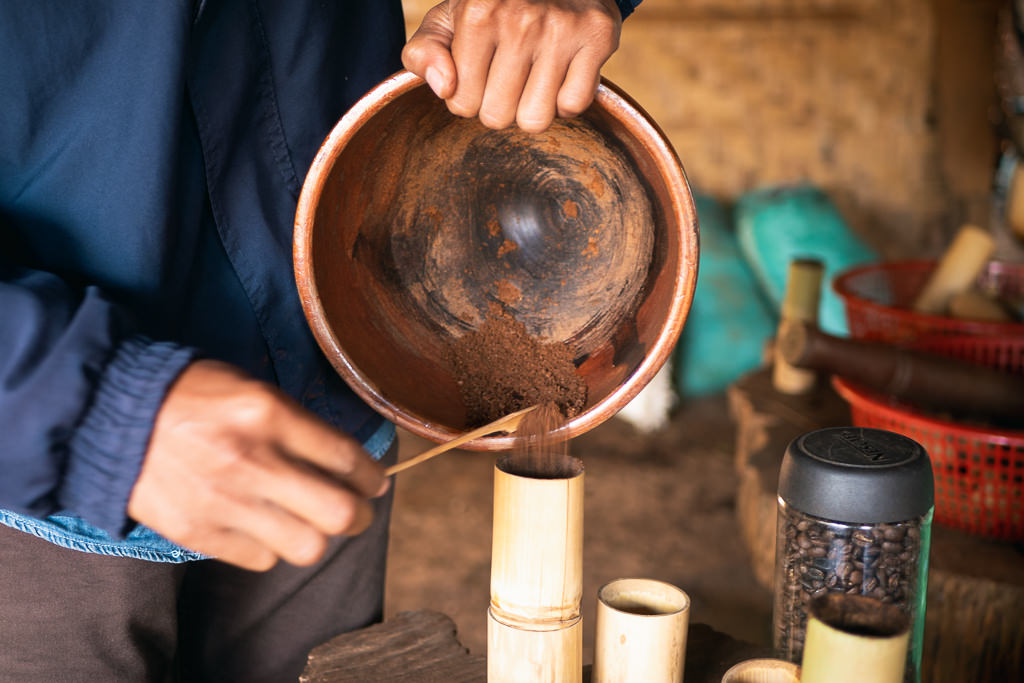
The village follows animist traditions and, if the stories are to be believed, they can be incredibly superstitious. One family thought to have brought ‘bad luck’ to the tribe was banished to the forest for ten years and their house burned to the ground. Most villagers are uneducated and believe the Earth is flat. According to Mr. Hook, they also regard all foreigners as French and believe people become white-skinned from a lack of work and only drinking milk. This is based of course on their impressions and memories of French colonists, so it makes some sense.
Apart from learning about the local beliefs and way of life, the tour also teaches a lot about the coffee growing process and about various herbs and plants found in the area.
I even tasted some live ants that were plucked from a tree, which had a wonderful lemony flavor and were very more-ish.
I liked that Mr. Hook’s tour was respectful of his own indigenous village, focusing mostly on the coffee farms and forest that surrounds it, thus avoiding being too intrusive in the villagers’ daily lives. The tour does include stopping inside the village for a nice cup of coffee, but you won’t be just there taking pictures of villagers, as sometimes happens on not-so-good tours.
Mr. Hook told me that the Laos government regularly visits to ensure the proceeds from the tours benefit the entire village, so it seems this is a kind of community-based tourism that’s not just interesting and entertaining but also worth supporting.
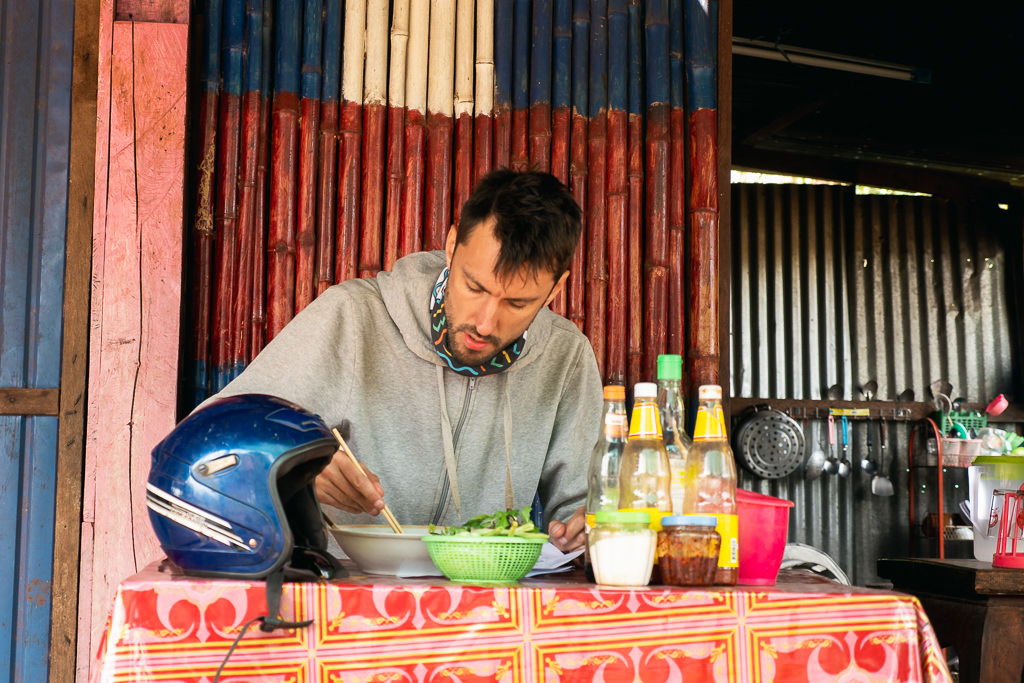
Stopping for pho at a roadside restaurant
Day 3: Tad Lo to Tad Tayicsua
This was probably my favorite segment of the route. Admittedly, this day did start with another 2 to 3 hours of driving through not too terribly exciting landscapes, although the farmlands and villages were nice.
But after the Tad Faek waterfalls, you start seeing more mountains and valleys, making things a lot more interesting.
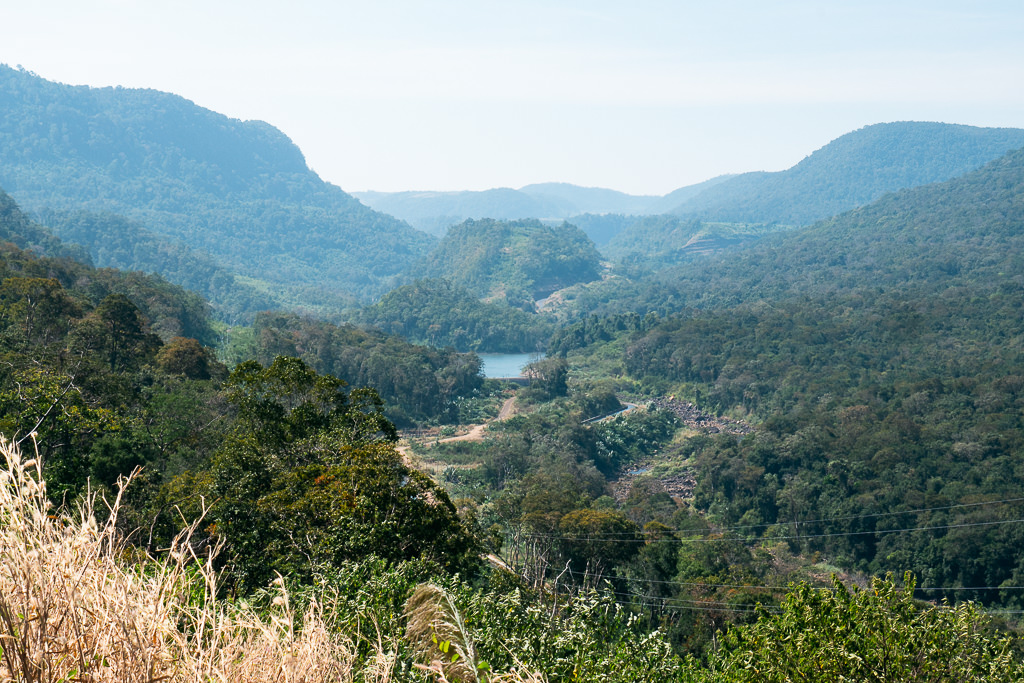
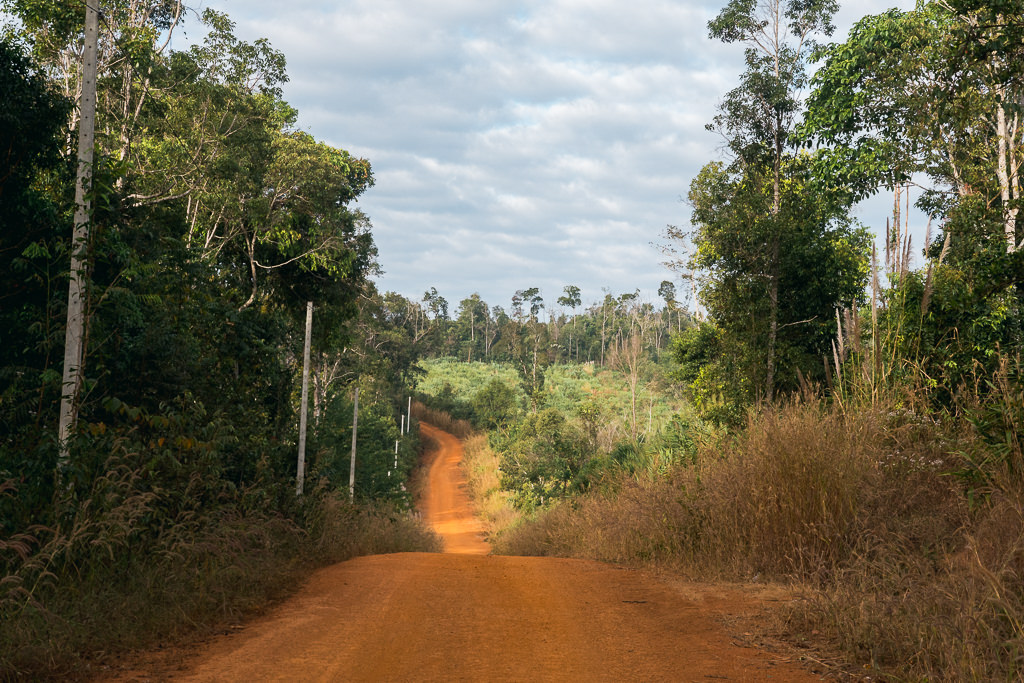
Tad Tayicsua was surely the most beautiful waterfall I saw on this trip, and possibly in all of Laos. Surrounded by lush vegetation and flowers, this waterfall produces a 360-degree rainbow when the sun hits it at the right angle.
You can eat or sleep at a guesthouse that’s a 10-minute climb up from here, then take your time to enjoy the waterfall in all its prismatic glory.
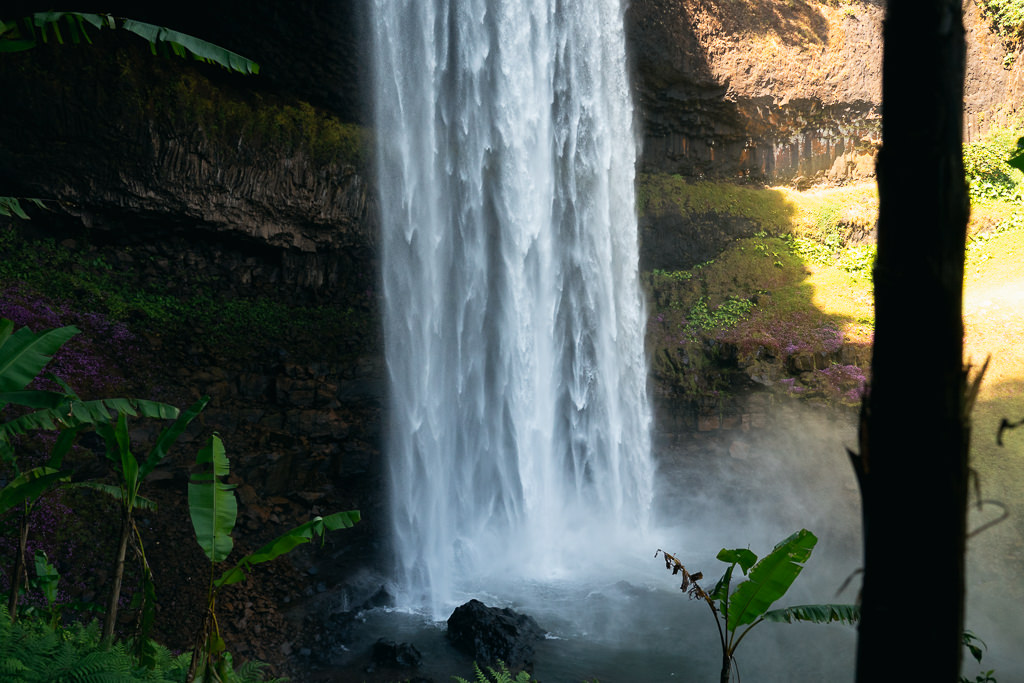
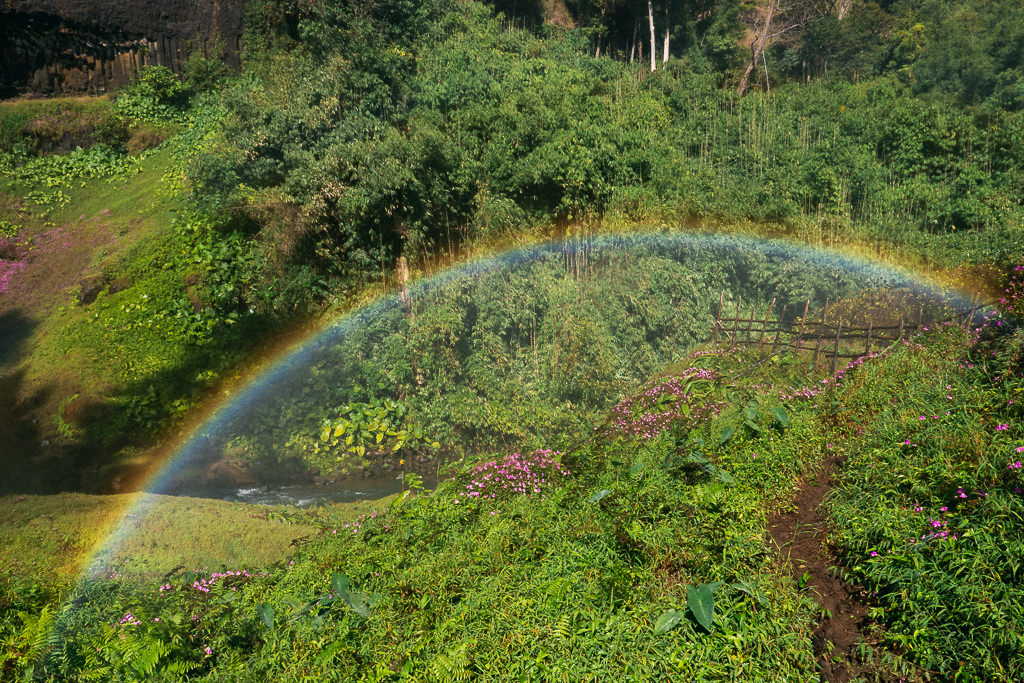
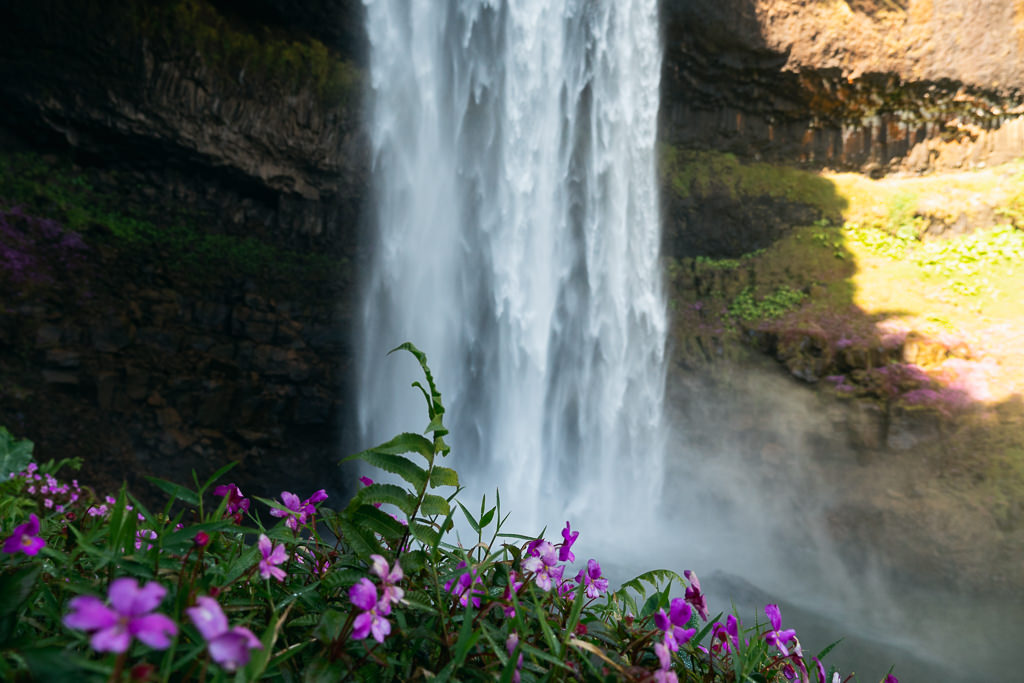
I was the only person staying here overnight, so it felt to me like the least-visited part of the loop. This makes sense as it’s the furthest from Pakse, but maybe it was just a coincidence. Either way, I can definitely recommend basing yourself here, as there are walking trails leading to other nearby waterfalls, and the scenery is wonderfully lush and green.
It was not obvious to me at first that there were any trails here — a fact that seemed glossed over in the various information sources I’d used. So, if you enjoy a bit of jungle hiking, then you should definitely stay near Tad Tayicsua.
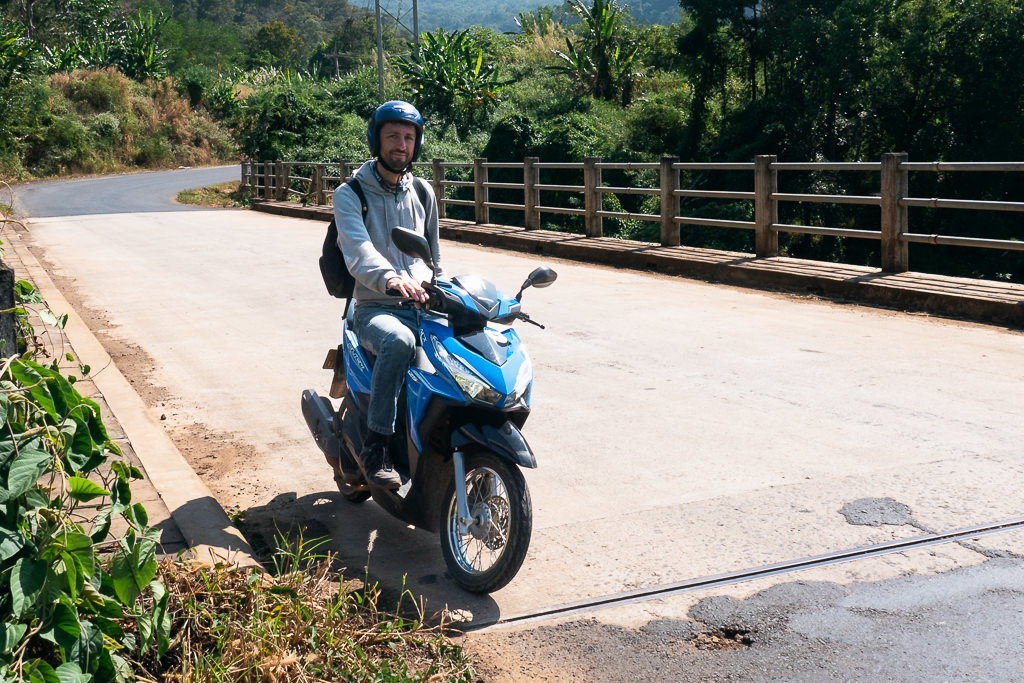
Day 4: Tad Tayicsua to Pakse
The final day passes by the largest waterfall of them all before bringing you back to Pakse.
On my way through Paksong, I stopped at the Jhai Coffee House, a social enterprise investing all their profits into local projects. These include clean water solutions for villages and educating farmers on coffee-growing practices.
The cafe is super cozy and welcoming and makes for a perfect little pit stop. I ended up meeting another motorcyclist here and sharing stories about our travels in Laos.
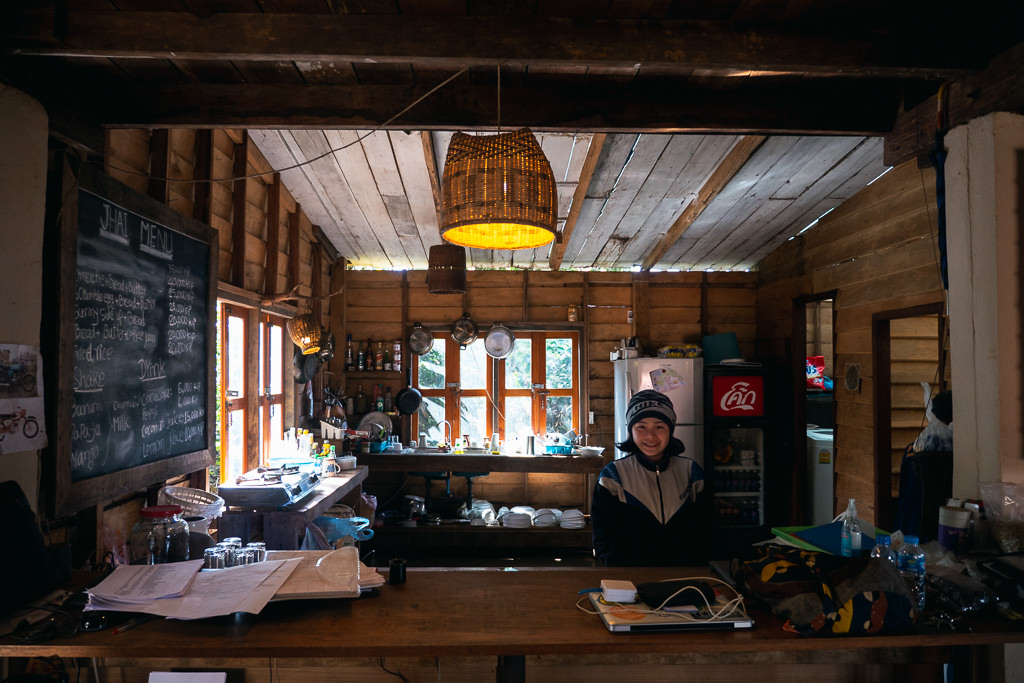
While the edenic Tad Tayicsua was my personal favourite waterfall, the award for most epic clearly goes to Tad Fane, which thunders down 100m into a huge jungle gorge.
You can’t get as close to this waterfall as to the others as it’s viewed mainly from a platform on the opposite side of the ravine, but this platform does offer the best angle to see it.
Well, truly the best angle may be from the zipline above it, an adrenaline-pumping activity for sure as you will be very high above the ground. The zip line is $40 each for 4 lines.
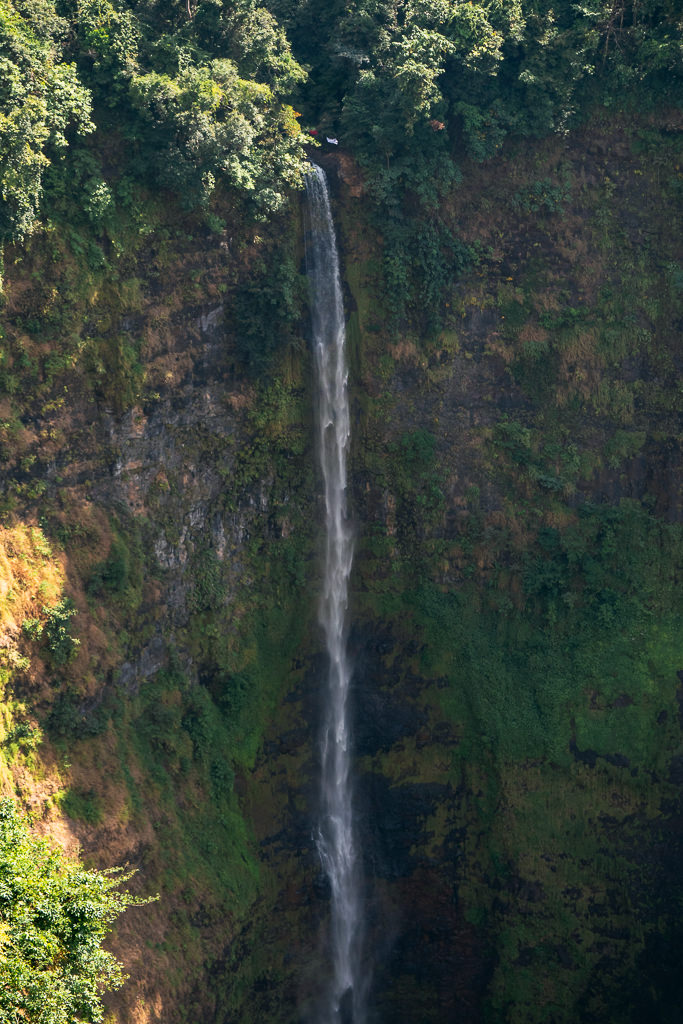
Although Tad Fane is highly impressive, it is the one sight in the Bolaven Plateau that is definitely a popular tourist spot. There may be a fair number of selfie sticks here. There is a small resort with wooden cabins where you can stay the night.
Since Tad Fane is about an hour’s drive from Pakse, it’s also possible just to see this waterfall as a tour or day trip.
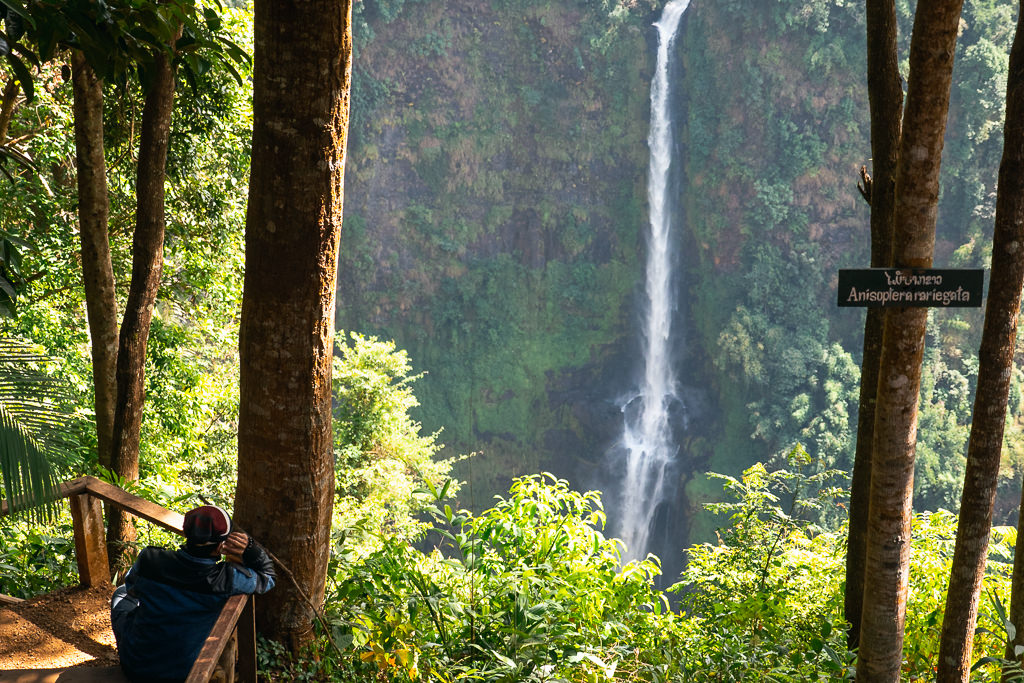
I was told that it’s a good idea to leave Tad Fane for Pakse by 4 pm to avoid driving at night and this was good advice. Unfortunately, I got held up a bit and so drove the last hour at night and in rush hour, which was quite tiring and stressful. Not only that, but I got lost in Pakse without a map as my phone battery went empty. I ultimately had to persuade a Laotian family to let me charge my phone in their house so I could find the correct way back!
Looking back at my trip through the Bolaven Plateau, I thought it was a wonderful experience with just the right balance between driving and sightseeing. If I had to do it again I’d maybe stay longer in Tad Tayicsua, and I would have made a stop at Mr Vieng’s cafe on the first day.
Before you set off, be sure to gather some local tips in Pakse, as there may be worthwhile stops on the route different from when I did this trip.
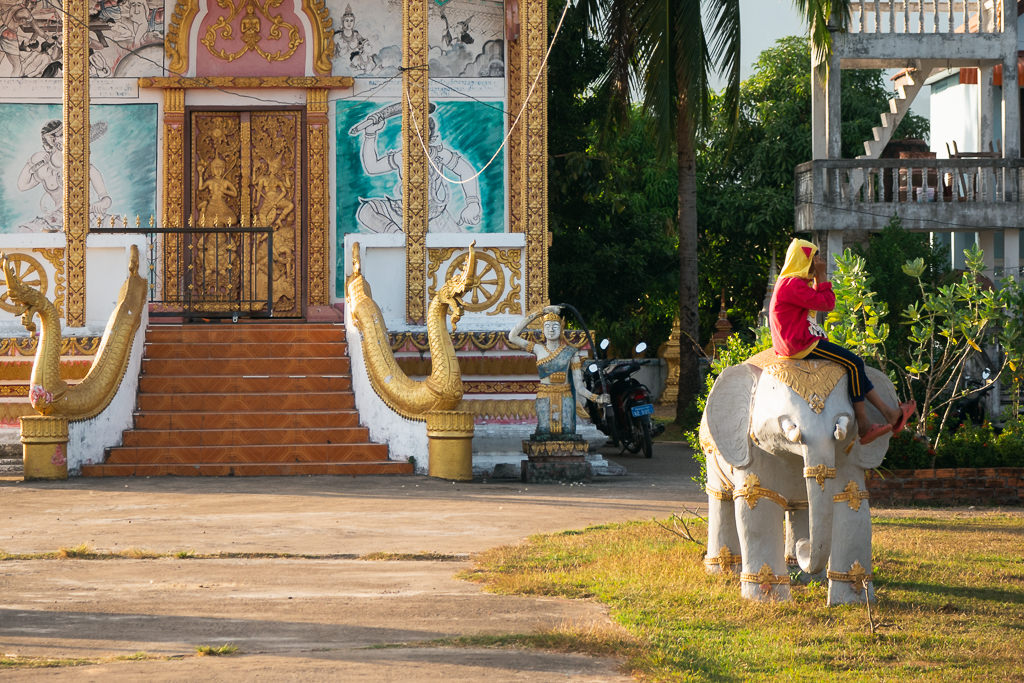
What to expect
To state the obvious: the Bolaven Plateau is… well, a plateau.
That means it’s very flat. This offers the advantage that the roads are also flat, making them easy to drive. On the other hand, the landscapes are not mountainous in the way that they are in northern Laos.
So, do not expect to see that many limestone mountains. The scenery you pass is certainly bucolic and rural, though this route is mostly about the cultural sights and stunning waterfalls.
The other thing to know is that the Bolaven Plateau is at 1000 to 1200m above sea level, making it colder than areas around the Mekong River. That offers a welcome relief from the tropical heat in the lowlands, though I have to say that on my visit in December it was, in fact, colder than a witches’ tit.
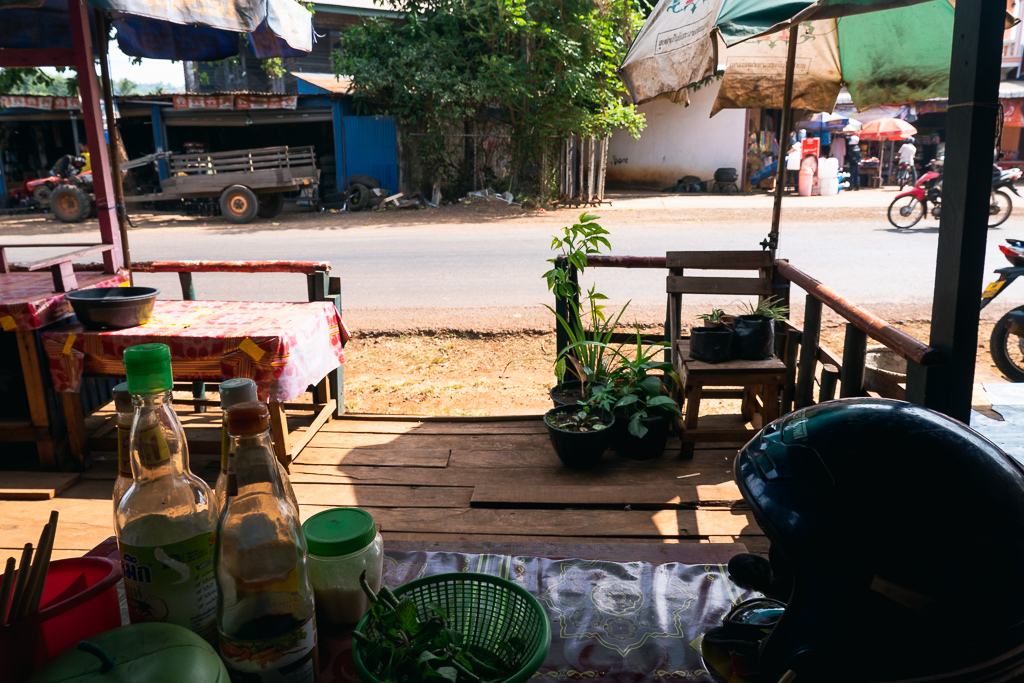
Having in mind only Laos’ tropical climate, I was not prepared for the cold while facing the winds on my motorbike. I kept stopping at little roadside shops selling made-in-China goods — first to buy some gloves, then for an extra hoodie, then a rain jacket, then some elastic bands to close up my sleeves. I eventually managed just enough layers to make the cold bearable.
I thankfully had a bandana that I used as a scarf, but I wish I’d also brought a good windbreaker — not something I usually pack for Southeast Asia. Apparently, there was an unusual cold front in the region at the time that made it colder than normal, but either way I recommend packing some warm clothing for this trip, either for when you’re on your bike, or for during the colder evenings.
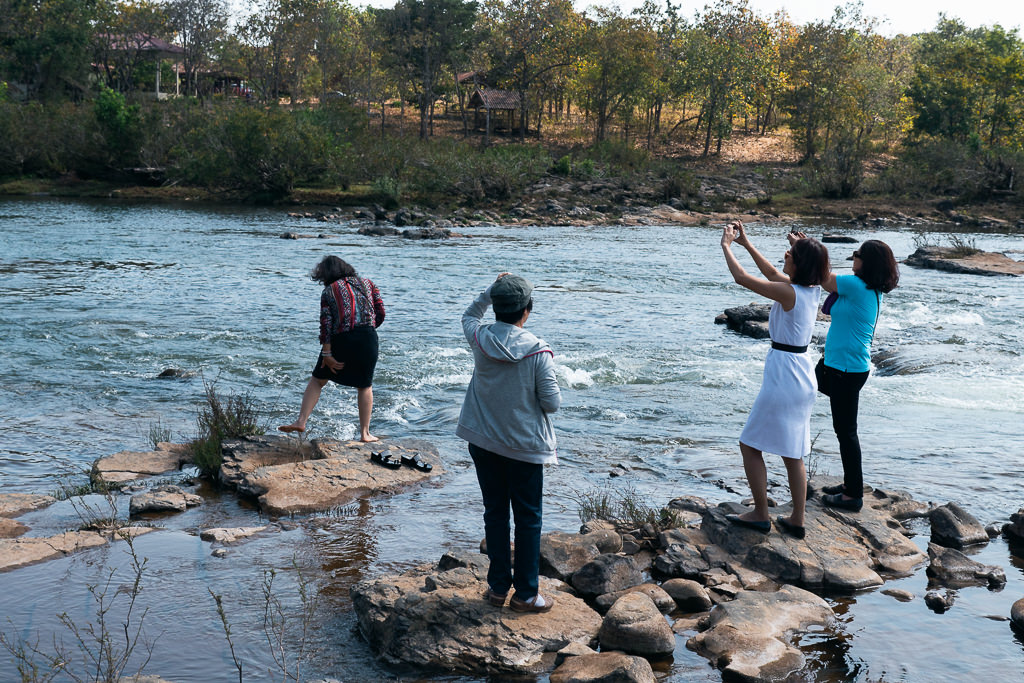
The atmosphere along the way is generally that of a somewhat off-the-beaten-track region. The fact is that 90% of visitors to Laos go to Luang Prabang and Vang Vieng in the north of the country. Many of those who make it to the south stick to the 4000 Islands area.
You will certainly meet other (international) travelers in Bolaven, though relatively few compared to the major destinations in Laos.
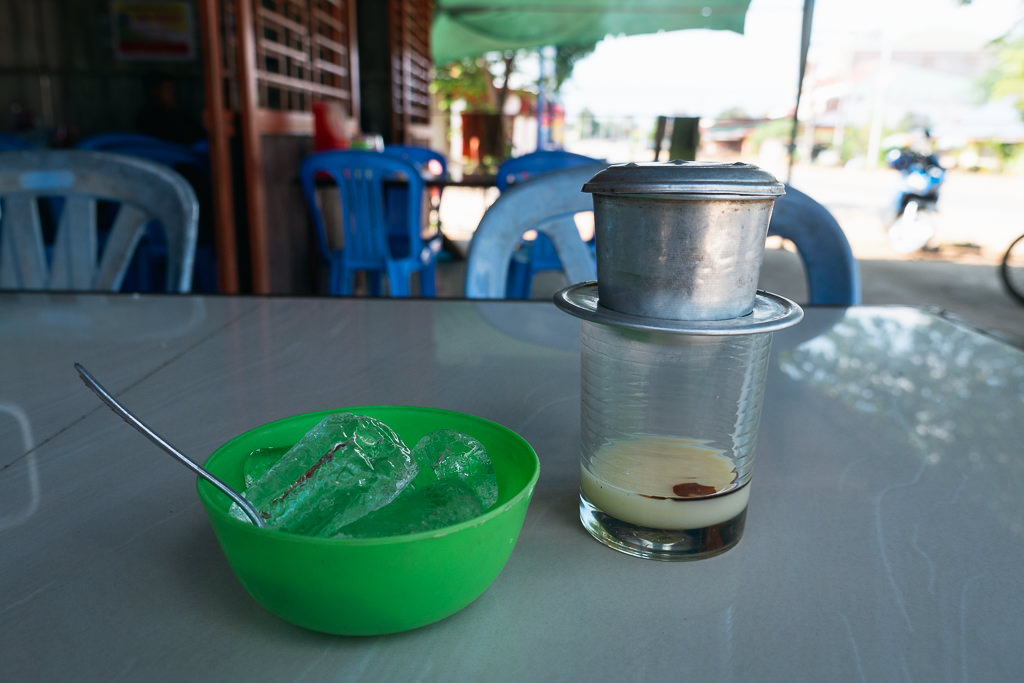
Road conditions
I had read a few things about the roads being bad, but I suspect roadworks have improved things here in recent years, as nearly all the roads were fine.
Only a few specific sideroads were dirt roads, but even these were mostly quite even and easy to ride. The worst roads I encountered (in 2018) were in the southeastern section of the big loop, though this was nothing worse than just a few scattered potholes.
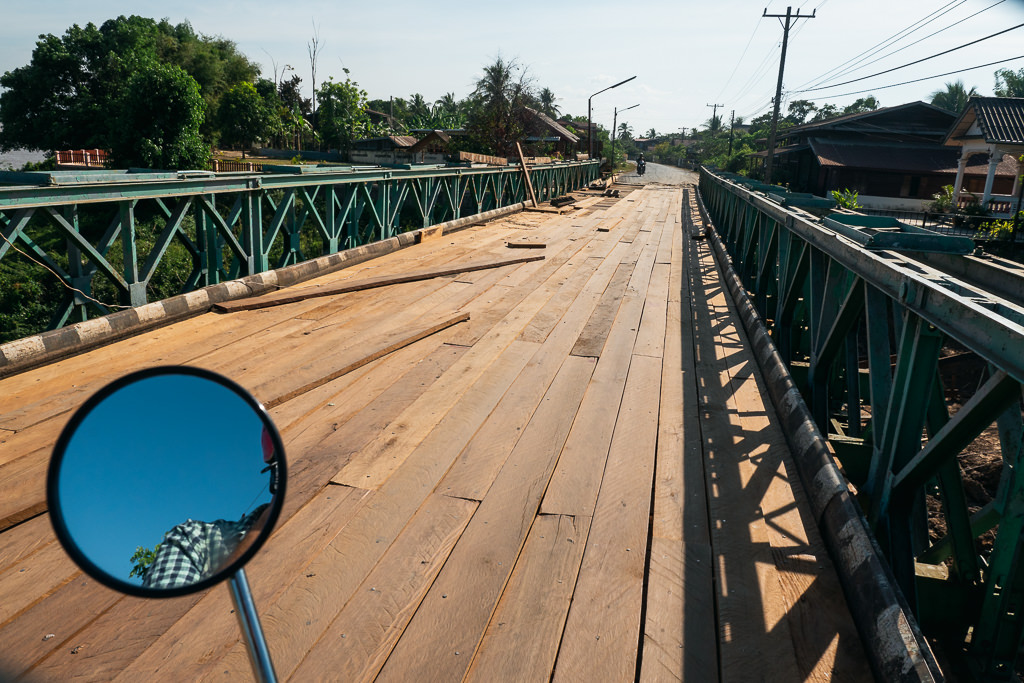
Since the roads are mostly flat, paved, and with not much traffic once you get outside of Pakse, I would rate the difficulty as easy. I’ve seen others describe the driving as “not for the faint of heart” but I disagree. The loop itself is really quite easy, but if you’re worried, ask around what side roads are best avoided.
Nevertheless, you should know how to drive a motorbike before embarking on this journey. Many backpackers in Asia end up being overconfident in their abilities and getting into accidents. It’s not just about driving at a reasonable speed. Potholes can be treacherous at any speed; I once had to take a fellow traveler to the hospital after she fell off her bike while driving no more than 10 km/hr on a dirt road.
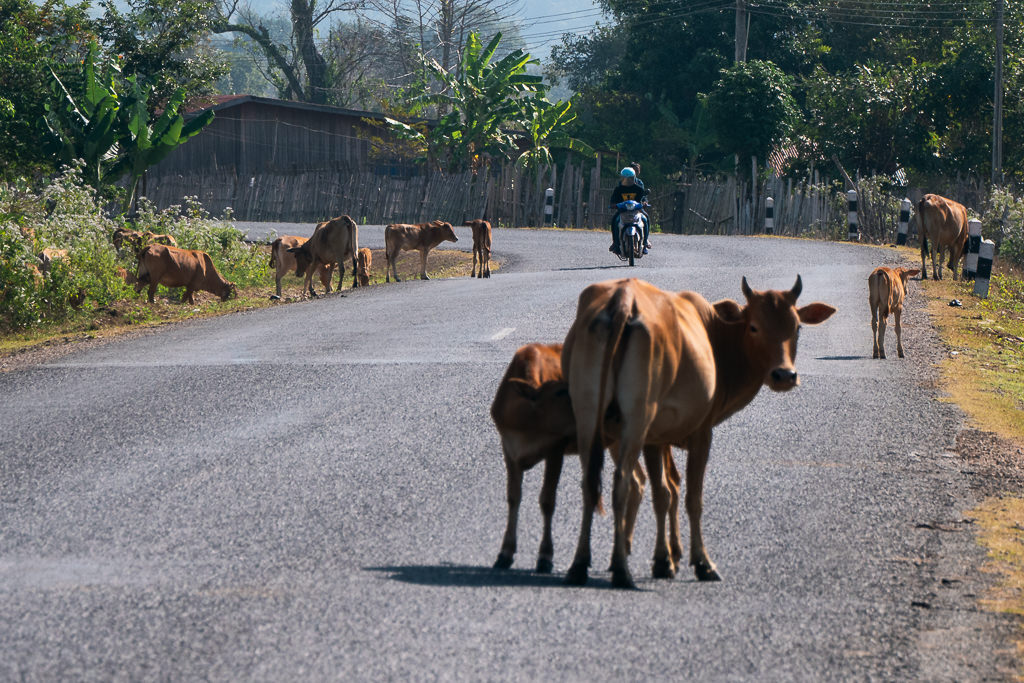
There were no sections that I would rate as dangerous (which is unlike other loops in Asia, such as the Ha Giang Loop in Vietnam which does have some tricky sections). However, good awareness of how to drive a scooter and how to anticipate rural traffic/cattle/etc. is essential.
How to do the loop
You can easily rent motorbikes in Pakse, where there are plenty of rental companies to choose from. The cost depends on the type of vehicle but you can count on something like $5 to $10 a day.
The Belgian/Laotian-managed Miss Noy Motorbikes is a good company to check out. They may charge slightly more than other Loatian-speaking only rentals, but it’s worth it for the detailed daily English-language briefings on the Bolaven Loop that they provide. Be sure to attend their presentation and take their photocopied map as they’re invaluable. (Following the pandemic closures, Miss Noy Motorbikes has reopened and is in business once again.)
The site Travelfish also did a great job explaining the big and small loops, and I recommend reading their excellent break-down.
Even though rental agencies in Laos typically won’t check for a driving license, it’s clearly best if you know how to handle a scooter before attempting this loop.
The minimum time needed is 2 days for the short loop. But if you have at least 3 days, I think it’s great to do the big loop, as it has some of the most beautiful waterfalls, some nicer scenery, and some great hiking trails as well.
Originally posted May 10, 2018. Updated in 2024.
Some links may be affiliate links, meaning I may earn commission from products or services I recommend. For more, see site policies.
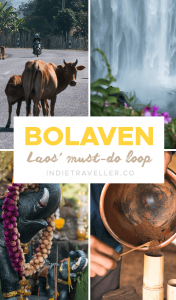
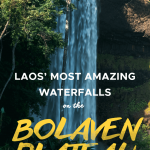
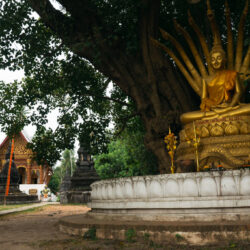
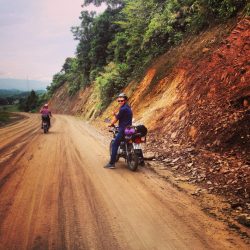




Thank you for this amazing guide! I’m going to follow this when I’m Laos next month. 🙂
Do you remember the name of the guesthouse above the waterfall Tad Tayicseua? I wonder if I can book a room etc online before I go there.
Yes, that was Tad Tayicsua Homestay. Sadly on Google Maps it says “temporarily closed”…
Hi, would you be able to provide rough driving times between Paksong (or Pakse) and Tad Lo, and between Paksong and Tad Faek or Tad Tayicseua? Trying to figure out if we can just base ourselves somewhere close to Paksong and do day trips out to these waterfalls if the driving distances aren’t too great. Thanks
Sorry, it’s been a while since I did this trip so I don’t remember the exact times! I wish I’d noted it at the time. Maybe you can inquire with a local hotel or motorbike rental as they may have up to date info.
Just to say the elephant bathing you reference, this is ‘owned’ by one of the hotels who use it for elephant trekking which for anyone to partake in, involves cruel torture of these magnificent creatures that should be in the wild. These elephants are also kept in chains. I beg anyone reading this blog not to promote or participate in this and to educate yourselves about what is really happening all for tourists to get some pictures with a ‘wild’ animal!!
Thanks for sharing. My only knowledge was of it getting bathed/fed.
Are there any group tours or drivers that could take me around? I don’t know how to drive or ride a motorbike.
Not sure about drivers but you can check local Laos tour operators, e.g. Green Discovery: https://greendiscoverylaos.com/pakse/
Hi Marek! Do you think it would be possible to do this route by bicycle? Since you say it’s mostly flat anyway I would hope that would be possible! I’d need more time of course, but that’s not a problem. Let me know what you think!
The main road seems great for cycling. The side roads to the waterfalls and such can be bumpy dirt roads. But I’d say it’s possible 🙂
Hello Marek,
Thanks for this great article. I am going to Pakse in one week and I am also planning to rent a motorbike to do the loop!
I’m just wondering what to do with my stuff during those three days while doing the loop. Do you know if there is a place in Pakse where I can store my bags?
Hey Mike. I left my large backpack at the place I rented my motorbike and only carried my daypack for the trip. If the rental place you use doesn’t have a bag storage facility you could also ask your hostel or guesthouse to store it for you (perhaps for a tip).
Thanks for this. Could you share a cost breakdown? That would help me so much
I don’t remember every detail, but my accommodation was always under $10 a night. The cheapest bikes at Miss Noy I believe were 60,000 kip a day (which is about $7) but it depends on the CC and brand. You might be able to find slightly better prices from other shops in Pak Se, though Miss Noy gives you a great briefing and support
Hi, when did you write this blog? The exchange rate you’re basing your scooter costs on must have changed dramatically because 60,000 kip is only about $2.70 now, not $7.
Sorry, this wasn’t updated in 2 years… kip has been volatile to say the least. It now has correct prices.
I rode the Thakek loop last year which has some great scenery. Have you done the Thakek loop and if so which ride did you prefer?
Didn’t have time for Thakek sadly. I think some of the karst mountain scenery there might honestly be more impressive (based off pics other travellers showed me). Bolaven has more waterfalls and other interesting stops but is very flat
That seems as an awesome experience! Is that a mini tractor I’ve seen?!
Great read! I don’t know much about motorbiking in Laos, but I’m getting quite inspired now.
Laos is such a fun country to do it! This and the Thakhek Loop seem to be the main routes 🙂